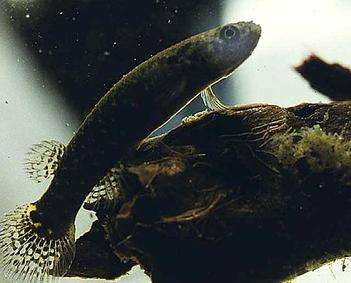October 21, 2015 report
Amphibious fish found to use evaporative cooling to overcome hot water

(Phys.org)—A team of researchers affiliated with the University of Guelph and Brock University, both in Canada, has found the first example of an amphibious fish using evaporative cooling to chill its overheated body. In their paper published in the journal Biology Letters, the researchers describe their study that included raising Kryptolebias marmoratus, aka mangrove rivulus, to adulthood and then testing them by heating the water in which they lived.
There are many varieties of amphibious fish—those fish that jump or crawl out of the water to hang out on land for awhile, but until now, no one has seen an example of one that jumps out of the water to use evaporative cooling to chill its body after swimming in water that was too hot. Prior research had shown that mangrove rivulus jump (or more accurately flip themselves out of the water by bending then releasing quickly) but it was not clear why they did so—other amphibious fish have been known to get out of the water if CO2 build up, or if there were pollutants, or even to snag a meal, but that did not seem to apply to the mangrove rivulus.
To find out more about the fish (which look sort of like tadpoles) the researchers raised some specimens for a year in tanks in their lab, at a temperature of 25 or 30°C and also collected wild adults and put them in tanks in their lab too, and acclimated them for a time at the same temperature as those they had raised. Then, they watched and filmed (with a thermal imaging camera) what happened as the temperature of the water was raised. The fish, as expected hurled themselves out of the tank onto "shore"—when the temperature reached approximately 36°C. The researchers also enclosed the fish tanks so that they could create different levels of humidity and found that the fish cooled better in lower humidity environments. They also found that despite high humidity, the fish could all cool themselves down to ambient temperature within minutes.
In studying the fish, the researchers found that not only was it able to use evaporative cooling, but its behavior also demonstrated plasticity, because it was dependent on recent acclimation history rather than conditioning when they were young. This suggests the fish is remarkably well suited to handling warmer waters as the planet heats up.
More information: Out of the frying pan into the air—emersion behaviour and evaporative heat loss in an amphibious mangrove fish (Kryptolebias marmoratus), Biology Letters, Published 21 October 2015.DOI: 10.1098/rsbl.2015.0689
Abstract
Amphibious fishes often emerse (leave water) when faced with unfavourable water conditions. How amphibious fishes cope with the risks of rising water temperatures may depend, in part, on the plasticity of behavioural mechanisms such as emersion thresholds. We hypothesized that the emersion threshold is reversibly plastic and thus dependent on recent acclimation history rather than on conditions during early development. Kryptolebias marmoratus were reared for 1 year at 25 or 30°C and acclimated as adults (one week) to either 25 or 30°C before exposure to an acute increase in water temperature. The emersion threshold temperature and acute thermal tolerance were significantly increased in adult fish acclimated to 30°C, but rearing temperature had no significant effect. Using a thermal imaging camera, we also showed that emersed fish in a low humidity aerial environment (30°C) lost significantly more heat (3.3°C min−1) than those in a high humidity environment (1.6°C min−1). In the field, mean relative humidity was 84%. These results provide evidence of behavioural avoidance of high temperatures and the first quantification of evaporative cooling in an amphibious fish. Furthermore, the avoidance response was reversibly plastic, flexibility that may be important for tropical amphibious fishes under increasing pressures from climatic change.
Journal information: Biology Letters
© 2015 Phys.org

















